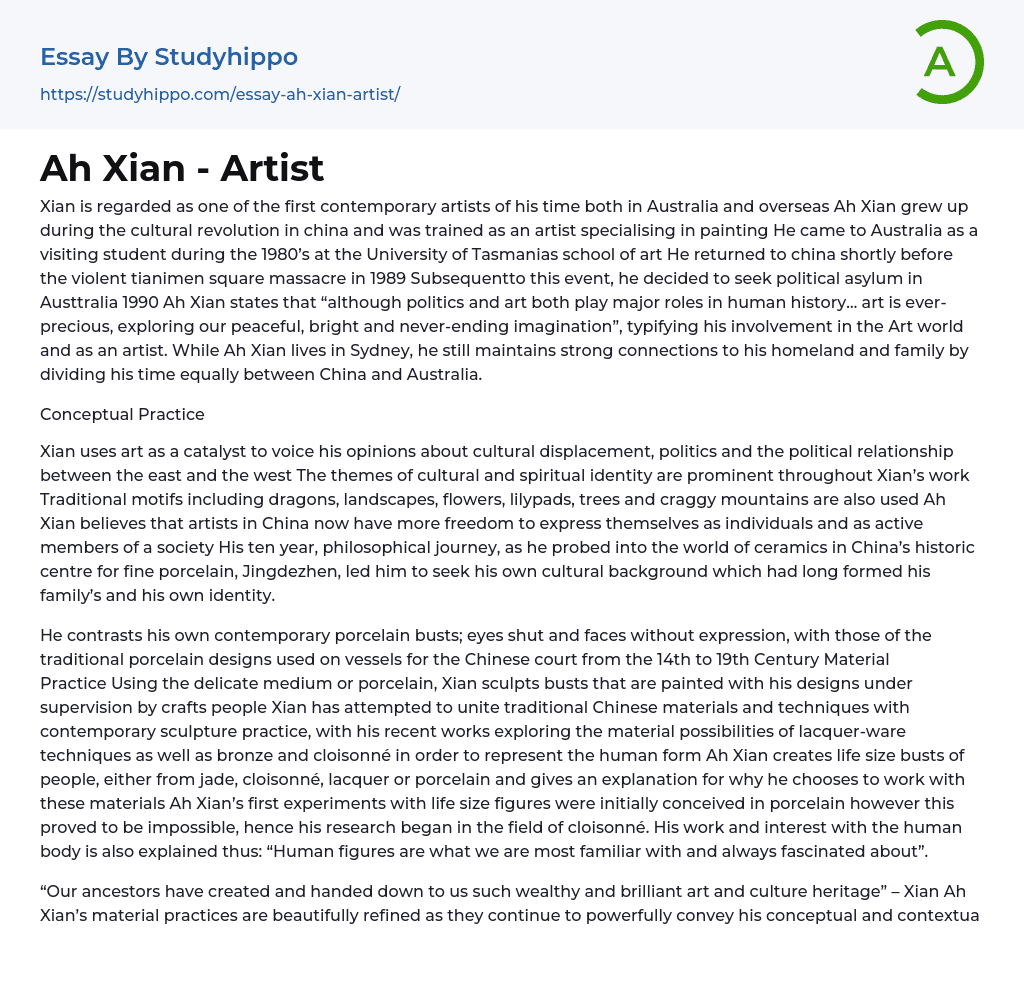Xian is regarded as one of the first contemporary artists of his time both in Australia and overseas Ah Xian grew up during the cultural revolution in china and was trained as an artist specialising in painting He came to Australia as a visiting student during the 1980’s at the University of Tasmanias school of art He returned to china shortly before the violent tianimen square massacre in 1989 Subsequentto this event, he decided to seek political asylum in Austtralia 1990 Ah Xian states that “although politics and art both play major roles in human history… art is ever-precious, exploring our peaceful, bright and never-ending imagination”, typifying his involvement in the Art world and as an artist. While Ah Xian lives in Sydney, he still maintains strong connections to his homeland and family by dividing his time equally between China and Australia.
-align: justify;">Conceptual Practice
Xian uses art as a catalyst to voice his opinions about cultural displacement, politics and the political relationship between the east and the west The themes of cultural and spiritual identity are prominent throughout Xian’s work Traditional motifs including dragons, landscapes, flowers, lilypads, trees and craggy mountains are also used Ah Xian believes that artists in China now have more freedom to express themselves as individuals and as active members of a society His ten year, philosophical journey, as he probed into the world of ceramics in China’s historic centre for fine porcelain, Jingdezhen, led him to seek his own cultural background which had long formed his family’s and his own identity.
He contrasts his own contemporary porcelain busts; eyes shut and faces without expression, with
View entire sample
Join StudyHippo to see entire essay
-align: justify;">Conceptual Practice
Xian uses art as a catalyst to voice his opinions about cultural displacement, politics and the political relationship between the east and the west The themes of cultural and spiritual identity are prominent throughout Xian’s work Traditional motifs including dragons, landscapes, flowers, lilypads, trees and craggy mountains are also used Ah Xian believes that artists in China now have more freedom to express themselves as individuals and as active members of a society His ten year, philosophical journey, as he probed into the world of ceramics in China’s historic centre for fine porcelain, Jingdezhen, led him to seek his own cultural background which had long formed his family’s and his own identity.
He contrasts his own contemporary porcelain busts; eyes shut and faces without expression, with
those of the traditional porcelain designs used on vessels for the Chinese court from the 14th to 19th Century Material Practice Using the delicate medium or porcelain, Xian sculpts busts that are painted with his designs under supervision by crafts people Xian has attempted to unite traditional Chinese materials and techniques with contemporary sculpture practice, with his recent works exploring the material possibilities of lacquer-ware techniques as well as bronze and cloisonné in order to represent the human form Ah Xian creates life size busts of people, either from jade, cloisonné, lacquer or porcelain and gives an explanation for why he chooses to work with these materials Ah Xian’s first experiments with life size figures were initially conceived in porcelain however this proved to be impossible, hence his research began in the field of cloisonné. His work and interest with the human body is also explained thus: “Human figures are what we are most familiar with and always fascinated about”.
“Our ancestors have created and handed down to us such wealthy and brilliant art and culture heritage” – Xian Ah Xian’s material practices are beautifully refined as they continue to powerfully convey his conceptual and contextual concerns with which he is so strongly tied. His work with this material, as an art critic aptly stated; “choosing porcelain as the material for the contemporary art is like the use of a double-edged sword – a sure way to both cure, it helps and possibly hurts yourself as well”.
- Pablo Picasso essays
- Vincent Van Gogh essays
- Michelangelo essays
- Frida Kahlo essays
- Aesthetics essays
- Art History essays
- Artist essays
- ballet essays
- Body Art essays
- Color essays
- Concert Review essays
- Creativity essays
- Cultural Anthropology essays
- Ethnography essays
- Harlem Renaissance essays
- Heritage essays
- Modernism essays
- Mona Lisa essays
- Pastoral essays
- Postmodernism essays
- Realism essays
- Symbolism essays
- Theatre essays
- Visual Arts essays
- Voice essays
- Work of art essays
- Architecture essays
- Design essays
- Graffiti essays
- Graphic essays
- Interior design essays
- Painting essays
- Photography essays
- Sculpture essays
- Typography essays




